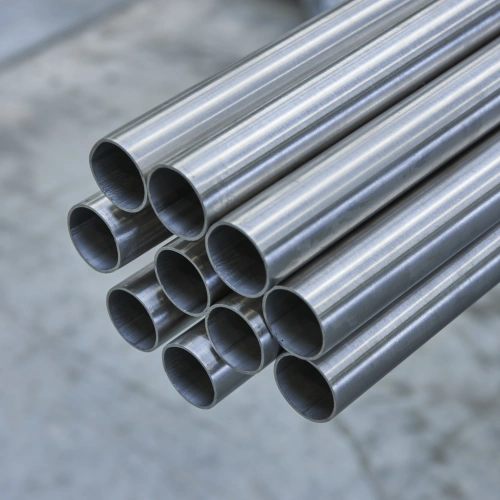Difference Between Stainless Steel Pipe vs Stainless Steel Tube
Understanding the difference between stainless steel pipes and tubes is essential when choosing the right material for your project. Both are used extensively across industries, but they serve distinct functions, have different manufacturing processes, and are designed for different applications. This article will clarify the key differences, helping you decide which one suits your needs best.

What is a Stainless Steel Pipe?
A stainless steel pipe is a hollow cylindrical tube primarily used for transporting fluids or gases. Its main characteristic is the internal diameter (ID), which dictates the volume of fluid or gas it can carry.
Manufacturing Process:
Stainless steel pipes are produced through methods like welding and extrusion. Welded pipes are made by forming a sheet of stainless steel into a pipe and then welding the seam, while seamless pipes are created by extruding a solid billet of stainless steel through a mold, which eliminates the need for welding.
Common Sizes and Specifications:
Pipes are typically measured by their internal diameter (ID) and the schedule number, which indicates the wall thickness. The most common pipe schedules are Schedule 40 and Schedule 80. with thicker walls providing better pressure resistance.
Typical Uses:
Stainless steel pipes are designed to handle pressurized fluids and gases, making them ideal for:
Plumbing systems in commercial and residential buildings.
Oil and gas pipelines, transporting crude oil, natural gas, and refined products.
HVAC systems, circulating air and refrigerants in heating, ventilation, and air conditioning.
Food and beverage industries, where sanitary and corrosion-resistant piping is necessary.
What is a Stainless Steel Tube?
A stainless steel tube is a hollow section that, like a pipe, can carry fluids, but it is generally used in more precision-driven applications. Stainless steel tubes are typically defined by their outside diameter (OD) and wall thickness, making them ideal for applications where exact dimensions are critical.
Manufacturing Process:
Tubes are produced through two primary methods: seamless or welded. Seamless tubes are created by drawing a billet through a die, resulting in a tube without any welded seams. Welded tubes, on the other hand, are made by rolling a flat sheet of stainless steel and welding the edges together.
Common Sizes and Specifications:
Unlike pipes, tubes are usually measured by external diameter (OD) and wall thickness, with more stringent tolerances to meet precision standards. Tubes are available in a wide range of sizes to fit various applications, and they tend to have thicker walls compared to pipes for added strength.
Typical Uses:
Stainless steel tubes are used where higher precision, strength, and durability are required, including:
Medical equipment such as surgical instruments and catheters.
Aerospace for structural components and tubing that need to withstand extreme conditions.
Automotive industries, where stainless steel tubes are used in exhaust systems and fuel lines.
Construction and architecture for decorative elements and structural supports.
Key Differences Between Stainless Steel Pipes and Tubes
Although both stainless steel pipes and tubes are used to transport fluids, they differ in several important ways:
Measurement:
Pipes are measured by internal diameter (ID). This makes them ideal for fluid transport, as the ID determines how much fluid can flow through the pipe.
Tubes are measured by external diameter (OD) and wall thickness. This precision makes tubes suitable for structural applications and industries requiring strict dimensional standards.
Manufacturing:
Pipes can be welded or seamless, with welded pipes being more cost-effective and commonly used for less demanding applications.
Tubes are also seamless or welded, but they are often manufactured to higher tolerances, making them suitable for applications where precision is critical.
Strength and Durability:
Pipes are designed to carry liquids or gases under pressure but are generally not as strong as tubes.
Tubes are stronger and more durable, making them ideal for high-stress and high-performance environments, like aerospace and medical applications.
Precision:
Pipes typically have lower precision, which is acceptable for fluid transport but unsuitable for structural applications.
Tubes have higher precision, which is essential in industries where exact measurements are crucial, such as medical or aerospace engineering.
Applications of Stainless Steel Pipes
Stainless steel pipes are predominantly used in fluid and gas transport, where pressure resistance and durability are key:
Water Systems: Stainless steel pipes are used in plumbing systems for both residential and commercial buildings, offering resistance to corrosion and ensuring safe water transportation.
Oil and Gas Pipelines: Stainless steel pipes are critical for transporting crude oil, natural gas, and refined products over long distances.
HVAC Systems: Stainless steel pipes circulate refrigerants in heating, ventilation, and air conditioning systems, withstanding high pressure and temperature variations.
Food and Beverage Industry: Stainless steel pipes are commonly used in food and beverage manufacturing for sanitary and hygienic fluid transfer, ensuring that contaminants are kept out.
Applications of Stainless Steel Tubes
Stainless steel tubes are designed for more specialized applications that require precision and strength:
Medical Equipment: Tubes are used for producing surgical instruments, implants, and catheters, where precision and corrosion resistance are essential for safety and performance.
Aerospace: Stainless steel tubes are used for structural components and other critical parts in aircraft, where both strength and weight are factors.
Automotive: Stainless steel tubes are used in exhaust systems, fuel lines, and frames, providing strength, heat resistance, and durability.
Construction and Architecture: Tubes are used for decorative and structural elements, such as handrails and support structures, where both aesthetics and strength are required.
Choosing Between Stainless Steel Pipe and Tube for Your Project
When choosing between stainless steel pipes and tubes, several factors should guide your decision:
Cost Considerations:
Pipes are generally less expensive than tubes due to simpler manufacturing processes. If your project requires fluid transport and budget is a priority, pipes are often the more economical option.
Performance Requirements:
If your project requires high strength, precision, or resistance to high pressure, tubes are the better option. Tubes are also ideal for structural applications that demand higher durability and precision.
Regulatory Standards:
Certain industries have strict regulatory standards that may require the use of tubes instead of pipes, particularly when precision and exact dimensions are essential. Make sure to check industry standards (e.g., ASTM, ASME) before making a decision.
In summary, stainless steel pipes and stainless steel tubes are both versatile materials used across industries but serve different purposes. Pipes are ideal for fluid transport, while tubes are used in structural and precision-driven applications. By understanding the key differences in their design, manufacturing, and uses, you can make an informed decision on which material best suits your project.
For more information on stainless steel pipes and stainless steel tubes, contact us today!
FAQs
What is the main difference between stainless steel pipes and tubes?
The primary difference is in their measurements. Pipes are measured by internal diameter (ID), while tubes are measured by external diameter (OD) and wall thickness. This distinction makes tubes more precise, ideal for structural and high-performance applications.
Can I use a stainless steel pipe as a tube?
In some cases, a pipe may serve as a tube, but it will lack the precision and structural integrity that a tube provides. Tubes are generally more durable and suited for applications that require exact dimensions.
Which one is stronger: stainless steel pipe or tube?
Stainless steel tubes are typically stronger and more durable than pipes due to their higher precision and thicker walls, making them ideal for structural applications.
How do I choose between a pipe and a tube for my project?
If your project requires precise dimensions, strength, or is used in a high-performance environment, tubes are the better option. For fluid transportation under pressure, pipes are typically sufficient and more cost-effective.
